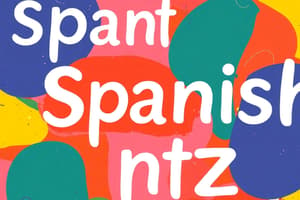Podcast
Questions and Answers
What percentage of the Spanish language vocabulary is derived from Latin roots?
What percentage of the Spanish language vocabulary is derived from Latin roots?
- Approximately 50%
- Almost entirely derived
- Largely derived (correct)
- Under 25%
Which of the following describes the sentence structure of Spanish?
Which of the following describes the sentence structure of Spanish?
- Verb-object-subject (VOS)
- Subject-verb-object (SVO) (correct)
- Object-subject-verb (OSV)
- Subject-object-verb (SOV)
In Spanish, how do adjectives relate to the nouns they modify?
In Spanish, how do adjectives relate to the nouns they modify?
- They always change their meaning based on the noun.
- They follow a fixed position before nouns.
- They must agree in gender and number. (correct)
- They can stand alone without alteration.
Which of the following is a distinctive feature of Spanish verb conjugation?
Which of the following is a distinctive feature of Spanish verb conjugation?
Which of the following characteristics is true about Spanish pronunciation?
Which of the following characteristics is true about Spanish pronunciation?
What is a significant influence on the development of Spanish vocabulary?
What is a significant influence on the development of Spanish vocabulary?
Which of the following is NOT a genre in Spanish literature?
Which of the following is NOT a genre in Spanish literature?
What role do colloquialisms play in Spanish communication?
What role do colloquialisms play in Spanish communication?
Flashcards
Spanish Language Origin
Spanish Language Origin
Spanish is a Romance language derived from Vulgar Latin.
Spanish Global Reach
Spanish Global Reach
Spanish is an official language in many countries and territories worldwide, spoken by over 500 million people.
Spanish Sentence Structure
Spanish Sentence Structure
Spanish typically follows a subject-verb-object (SVO) sentence structure.
Spanish Noun Gender
Spanish Noun Gender
Signup and view all the flashcards
Spanish Vocabulary Roots
Spanish Vocabulary Roots
Signup and view all the flashcards
Spanish Pronunciation Challenges
Spanish Pronunciation Challenges
Signup and view all the flashcards
Spanish Verb Conjugation
Spanish Verb Conjugation
Signup and view all the flashcards
Spanish Literary Styles
Spanish Literary Styles
Signup and view all the flashcards
Study Notes
General Notes on Spanish Language and Culture
- Spanish is a Romance language, descending from Vulgar Latin, spoken by over 500 million people globally.
- It's an official language in 20 countries and several territories.
- Spanish has numerous dialects across different regions, each with unique vocabulary and pronunciation variations.
- The language is rich in literature, encompassing various genres and styles throughout history.
- Spanish culture is highly diverse, encompassing a wide array of artistic, culinary, and social traditions in its different regions.
Spanish Grammar
- Spanish uses subject-verb-object (SVO) sentence structure in most cases.
- Nouns have grammatical gender (masculine or feminine).
- Adjectives agree in gender and number with the nouns they modify.
- Spanish has different verb conjugations for different tenses and moods (e.g., present, past, future, conditional).
- Verb conjugation patterns differ depending on the person (first, second, or third person) and number (singular or plural) of the subject.
- Indirect object pronouns (e.g., me, te, le, nos, os, les) affect verb conjugation.
- Spanish employs various grammatical structures for expressing different meanings, such as the use of prepositions and articles.
Spanish Vocabulary
- Spanish vocabulary is largely derived from Latin roots.
- Spanish borrowed words from various languages throughout its history, for instance, Arab, French, and English.
- Different regions and social groups may use distinct terminology.
- Specialized vocabularies exist for specific professions, fields of interest or artistic styles.
- Colloquialisms and slang are common in everyday conversations, which can vary significantly by region and generation.
Spanish Pronunciation
- Spanish employs a relatively straightforward phonetic system.
- Proper pronunciation is important for effective communication and understanding in Spanish-speaking contexts.
- Various sounds in Spanish, such as 'j', 'll', and 'ñ', may pose challenges for non-native speakers.
- Accentuation differs from one word to another, and in such aspects, the context is crucial
Spanish Literature
- Spanish literature spans a long period, from medieval texts to contemporary works.
- Prominent authors from Spain and Latin America made substantial contributions to literature in Spanish.
- Notable literary genres in Spanish include poetry, prose, and drama.
- Spanish literature reflects the cultural and historical contexts of different periods and regions.
- The diverse characteristics of Spanish affect the content and style of the writing and make it unique.
Spanish Culture
- Spanish culture encompasses a broad spectrum of traditions, customs, and rituals.
- There are marked differences in cultural values and traditions across Spain and its different regions.
- The history and culture of the Spanish-speaking world encompasses vast differences.
- Spanish culture embraces a plethora of artistic expressions, including music, painting, dance, and architecture.
- Gastronomy plays a vital role in Spanish culture and society overall, with significant regional variations in culinary aspects.
Studying That Suits You
Use AI to generate personalized quizzes and flashcards to suit your learning preferences.
Description
Explore the fascinating world of the Spanish language and its rich cultural heritage. This quiz covers essential grammar rules, dialect variations, and key aspects of Spanish literature and traditions. Discover the diversity that makes Spanish unique across the globe.




